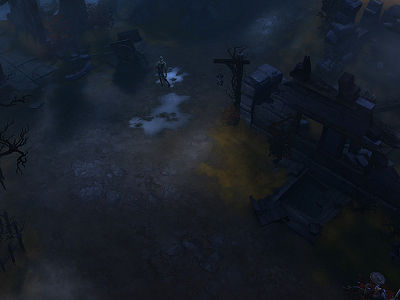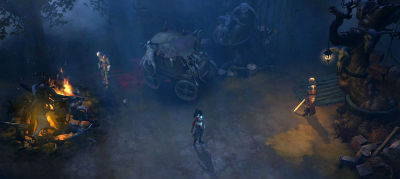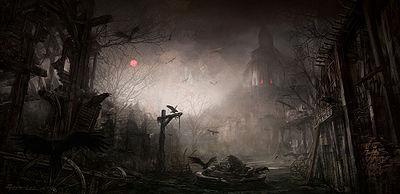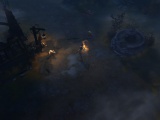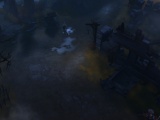Difference between revisions of "Tristram"
m (moved New Tristram to Tristram over redirect) |
m |
||
| Line 53: | Line 53: | ||
===The Lone Hero=== | ===The Lone Hero=== | ||
[[File:Original_Tristram1.png|thumb|right|400px|[[Diablo I]] layout of Tristram, with expansion (the player has reached the Hell levels).]] | [[File:Original_Tristram1.png|thumb|right|400px|[[Diablo I]] layout of Tristram, with expansion (the player has reached the Hell levels).]] | ||
| − | Many adventurers | + | Many adventurers disappeared down into the catacombs in search for treasure, glory or both. |
Revision as of 12:20, 18 January 2010
- This page covers Tristram as it is seen in Diablo III as well as its history up to this point. See also:
- Tristram -- The town in Diablo II.
- Uber Tristram -- Reached via the end game quest Pandemonium Event.
- Tristram -- The town in Diablo I and Hellfire.
- Tristram -- The town in Diablo II.
- This page covers Tristram as it is seen in Diablo III as well as its history up to this point. See also:
New Tristram is one of the towns in Diablo III. It's a wretched, rotting corpse of a town, grown up on the ruins of the old Tristram that blossomed during past ages, but has now fallen back into decay.
Tristram will be the starting town in Diablo III.[1]
Contents
Description
Tristram is a shell of its former self, with some burned down buildings still not removed. A "New Tristram" grew from the shell of the old one, built on the adventurers who seeked the treasures of the Cathedral, but when they left, the new town also lost it's soul.
The wilderness surrounding Tristram is beautiful with lush fields and picturesque rivers. [2] It's located fairly close to the fishing village called Wortham.
Background

The Horadrim
The history of tristram starts several hundred years prior to recent events (that take place around 1260-1290 Anno Kehjistani). In the last century of the first millennium, 912 to be precise, the Sin War ended when Diablo was finally captured in a Soulstone by a group of Horadrim monks led by Jered Cain. The monks buried the Soulstone in a cave near the river Talsande in Khanduras and a Horadric monastery with a network of catacombs was built over the location.
A few years after the erection of the monastery, the town of Tristram was founded around it and people prospered with the Prime Evils out of the picture. Unfortunately, with no quests left to undertake, the Horadrim's numbers slowly dwindled, and 200 years later, they are legends that are forgotten by most, the monastery long since abandoned.
Although villages grew and thrived around the shell of the old Monastery, no one knew of the dark, secret passageways that stretched into the cold earth beneath it. None could have dreamed of the burning red gem that pulsed within the labyrinth's heart...
King Leoric and Diablo
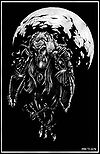 King Leoric's madness. |
 Prince Albrecht's corruption. |
It was at this time that the Eastern lord Leoric came to Tristram and declared himself king, and converting the old, long-unused Horadric monastery to a Zakarum cathedral. He was betrayed by his advisor, Archbishop Lazarus, who secretly released Diablo deep within the monastery catacombs.
Diablo knew Leoric was a strong man and attempted to possess him. King Leoric was indeed strong and managed to resist, but was driven mad instead, imprisoning and executing anyone who questioned his authority. He also started a war against Westmarch, despite common sense, as the armies of Khanduras were easily outnumbered.
Failing to possess Leoric, Diablo turns to Prince Albrecht instead, kidnapping him and possessing his soul and body.
When Lachdanan, captain of King Leoric's army, returned, Leoric had gone even more mad by the loss of his only son and Lachdanan had no choice but to kill his king. The fallen monarch cursed Lachdanan and his followers with his dying breath. Not long afterwards, Lachdanan and the king's guards were attacked by Leoric, resurrected as the Skeleton King, as they attempted to bury him.
The Lone Hero
Many adventurers disappeared down into the catacombs in search for treasure, glory or both.
Archbishop Lazarus then lead a group of villagers into the cathedral and abandoned them to a bloodthirsty butcher demon. From this point, people began fleeing Tristram in droves. If they had not left during the king's madness, they left now.
Only a small number of villagers stayed and saw a lone hero arrive and defeat the fetid butcher demon. This hero was one Deckard Cain befriended, and with his guidance, he ventured further down into the maze and defeated the Skeleton King as well as killing Lazarus.
The hero traversed all the way into Hell and defeated Diablo.
Unfortunately for the hero, as well as everyone else, the hero foolishly thinks he can contain Diablo within himself, and sinks the Soulstone within his own flesh.
The Dark Wanderer

Despite his noble intentions, his valiant spirit quickly succumbed to Diablo's corruption and he became the Dark Wanderer. He left Tristram behind shortly before legions of foul demons attacked and destroyed the town and its inhabitants: Killing some, raising them as skeletons, or possessing them, making them as demons, like poor Griswold.
A group of heroes began a quest to defeat Diablo and his brothers, visiting Tristram to save the only surviving soul from the town: Deckard Cain, a descendant of the Horadrim mage Jered Cain.
Cain blamed himself that he did not foresee this, and travelled East with the heroes to save Sanctuary.
New Tristram
After the town was burned to the ground, "New Tristram" grew around the ancient monastery. The new town has been around for several years, but the exact date of its founding is unclear.
Originally simply a collection of merchants looking to profit on adventurers and travellers drawn by legends of riches within the old cathedral, it slowly set down roots and became an established town. As soon as the cathedral was looted bare, however, the adventurers and travellers stopped coming, and New Tristram found itself in decline.
What happened here is now as with most of the Diablo Legend, something dismissed out of hand by most citizens of the world. People think of the undead monstrosities, demonic possession and the monarchy driven to lunacy to be part of a peculiar mould upon the bread or perhaps a fouling of the water. It was just an unfortunate event that people went mad.
Deckard Cain has returned to Tristram, looking for clues on what the demons and angels are up to.
Tristram in Diablo III
New Tristram is the starting town of Diablo III,[3] one of the many things the D3 Team has been inspired of from Diablo I.
There's a lot of concept art of Tristram, but it's not clear how much was just for background information or reference. The New Tristram so far seen in the game has been a zombie-infested ruins; if there's more of a town waiting to be discovered in the final game, we've not seen in-game evidence of it yet.
Numerous screens have shown New Tristram, but only the ruined, monster-infested portion of the town. The BlizzCon 2008 demo build started in a very small encampment just outside of New Tristram, but there were no NPC merchants available. It's assumed that the New Tristram we'll see in the final game will be larger and have various merchants and quest-giving NPCs, but this is just conjecture.
Tristram's Layout
This was also addressed by Flux in a comment on his BlizzCon gameplay report[4]:
- As for the geography, it's not recognizable as the same town from D1, but it's clearly inspired by it. The whole ruined town is much larger than in previous games, but that's understandable since it's been 20 years and the town was destroyed and rebuilt (and is now being destroyed again). There are about 15 or 20 ruined structures clustered in the center of the map. One has a broken wooden sign that hovers as "Griswold's Fine Weapons" if you point at it. No sign of Griswold or any other recognizable NPCs though.
- The basic landmarks remain; the monastery is still to the top left of town, with a graveyard beside it (lots of zombies burrow up out of the earth if you enter and hang around there). The biggest change is that the left side of town, about where the creek was between town and Wirt, has become a deep gorge that provides an impassible boundary to that side of the level. Adria's island and the creeks on the right side of the map aren't there anymore. Instead there are lots of ruined houses scattered over in that direction, and to the far right you find a few lightly forested areas with wide paths through them. Two other landmarks are along the left side of town, by the gorge. The well within which the little girl's ghost is trapped, and further north a spooky, Halloween tree out of which a bunch of zombies moaningly-emerge, if you remain in the vicinity.
- It's hard to estimate size since the path you take through the area is so winding; there aren't any straight roads and the houses and boulders and dead trees are scattered everywhere. But I'd say the whole area is maybe 6 or 8x the size of Tristram in D2. I think it was a non-random area; possibly the ruins and other town elements change around slightly from game to game, but the overall size and shape remained the same in each game I played.
Diablo III Description
Tristram was the starting point for the playable demo at Blizzcon, in October 2008. There was no town to speak of; just a very small camp with only two NPCs, and no merchants. From there players proceeded into the fog-shrouded ruins of Tristram Cathedral, battling undead every step of the way. The setting was described in some detail in a gameplay report by Flux:
- The mood continued as soon as a player moved out into the ruins of Tristram. The scenery was dark and oppressive, and no, the screenshots don't at all do it justice. The floating, partially transparent mist looks so much better in the game than in the screenshots, where it just makes things look smudged and blurry. The black, gnarled trees, clusters of crows that flew away when the player got close enough to trigger them, dozens of ruined, blasted houses you could run through, bodies lying here and there, and small bunches of zombies to rout gave the area a great, creepy, doomed mood.
- There were a number of nice set pieces elsewhere in Tristram that added to the mood. A human hand is seen at one point, clawing at the earth, before being yanked down into a dark cellar from which come horrible screams and a fountain of blood. Ghosts wander the streets, sobbing quietly and pathetically. Zombies are seen gnawing on corpses, and their moans and groans are very horror movie appropriate.
Media
- Original Tristram1.png
Tristram from Diablo I
Tristram in Diablo II.
Inside Tristram Cathedral.
Reference
- Flux's gameplay report
- Timeline
- WWI 2008 Lore & Art Panel
- BlizzCon Demo Discussion
- Blizzard's official lore page - New Tristram
- Diii.net's screenshot gallery
- Abd al-Hazir entry no. 20 - Gnarled Walkers
- Abd al-Hazir entry no. 17 - Tristram Cathedral
- Abd al-Hazir entry no. 16 - New Tristram
- Diablo I Manual
- Diablo II Manual
| Diablo III Levels [e] | |||
|---|---|---|---|
| Act I: Khanduras | Act II: Borderlands
|
Act II continued
|
Act III: Barbarian Lands |
